We Drove 1,118 Miles To Play 5 Of The UK's Best Links Courses. Here’s What We Discovered...
Mike Harris and three playing partners headed off on a Top 100 courses road trip to play five different seaside layouts with lots in common, but plenty of differences, too
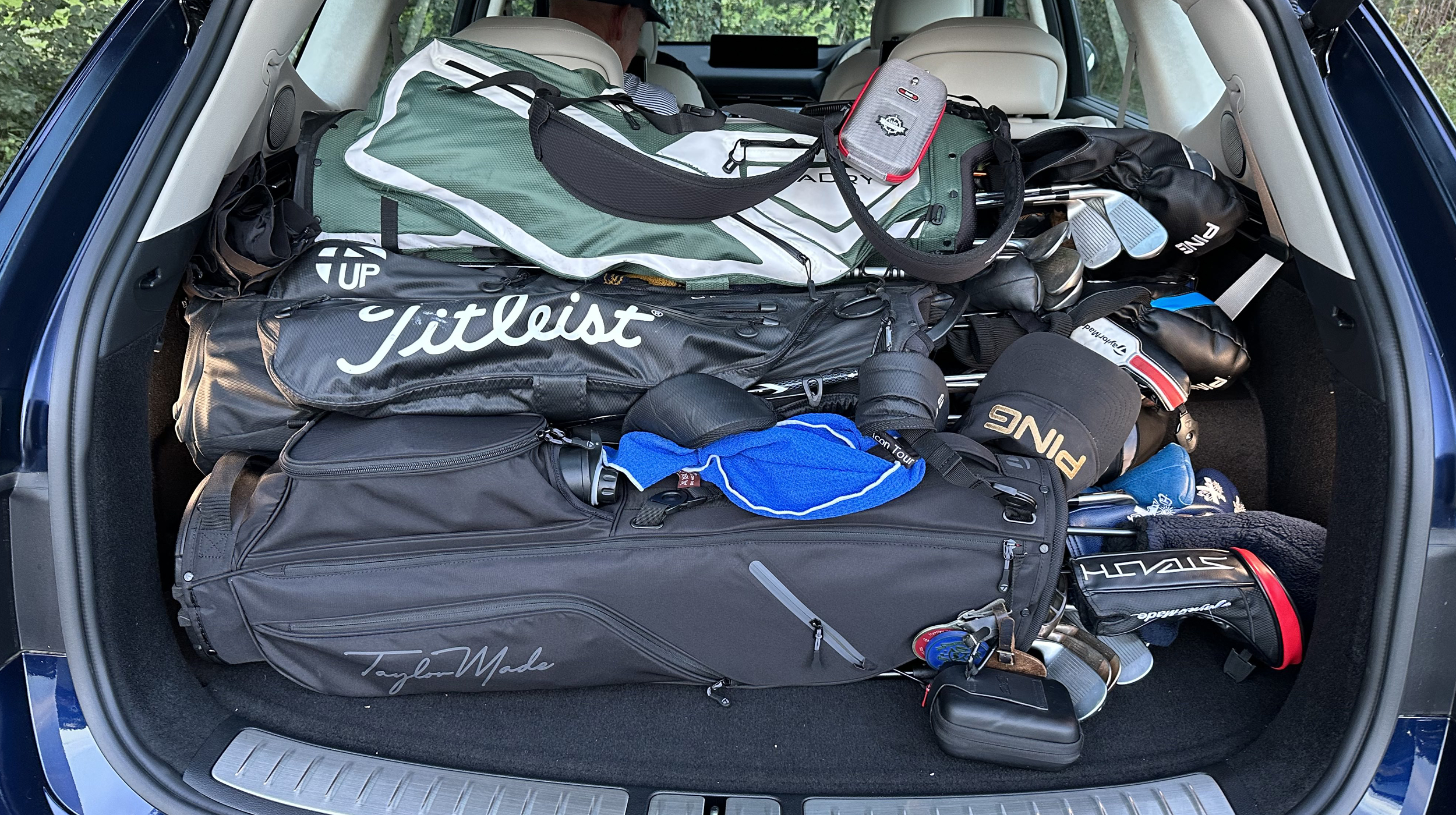

One of my favourite golf books is the simply titled ‘Links Golf’, written by Malcolm Campbell (former Golf Monthly editor) and George Peper (former Golf Magazine editor). In the book they explain the origins of links golf and defining factors that go into making a links golf course: Sea views or close proximity to the sea, sandy dune like terrain and fast running fairways buffeted by changing maritime winds.
According to their criteria, at the time the book was published in 2010, there were actually only 246 true links courses in the world with very few genuine links being added to that number each year due to the stringent criteria and lack of accessible sites on which to build true links courses.
To those new to links golf, it might seem like the courses can be one-dimensional, flat and often featureless with many having a routing that features nine (or thereabouts) holes playing in one direction before the course makes an about turn and plays back towards the start point.
Inland courses, by comparison, have much more potential variety, with changes in elevation, water hazards, different types of trees, flora and fauna and routings that often take you on two loops of nine that each return to the clubhouse.
However, to dismiss links golf as one-dimensional is to miss the bigger picture. The five courses that we played on this trip underline the devil is very much in the detail when it comes to links golf.
The differences between the five courses were both subtle and striking at the same time, most notably from the total lack of sea views at our first stop on England’s North West coast, Southport & Ainsdale, to magnificent views of the Firth of Forth and every single hole at our final stop, Dumbarnie Links in Fife.
For a road trip of this magnitude, a large, comfortable car is essential, and in the Genesis GV80 we had the perfect ride. The GV80 is the largest SUV in the Genesis range and is a stunning looking vehicle, especially from the front with it’s big diamond grille and split headlights - and it regularly turned heads on the trip.
Get the Golf Monthly Newsletter
Subscribe to the Golf Monthly newsletter to stay up to date with all the latest tour news, equipment news, reviews, head-to-heads and buyer’s guides from our team of experienced experts.
The layout of our GV80 featured up to three rows of seats. We could have had seven people in the car, but for our trip we needed the cavernous boot space to accommodate four sets of golf clubs, luggage and paraphernalia. It did a superb job of accommodating everything we took.
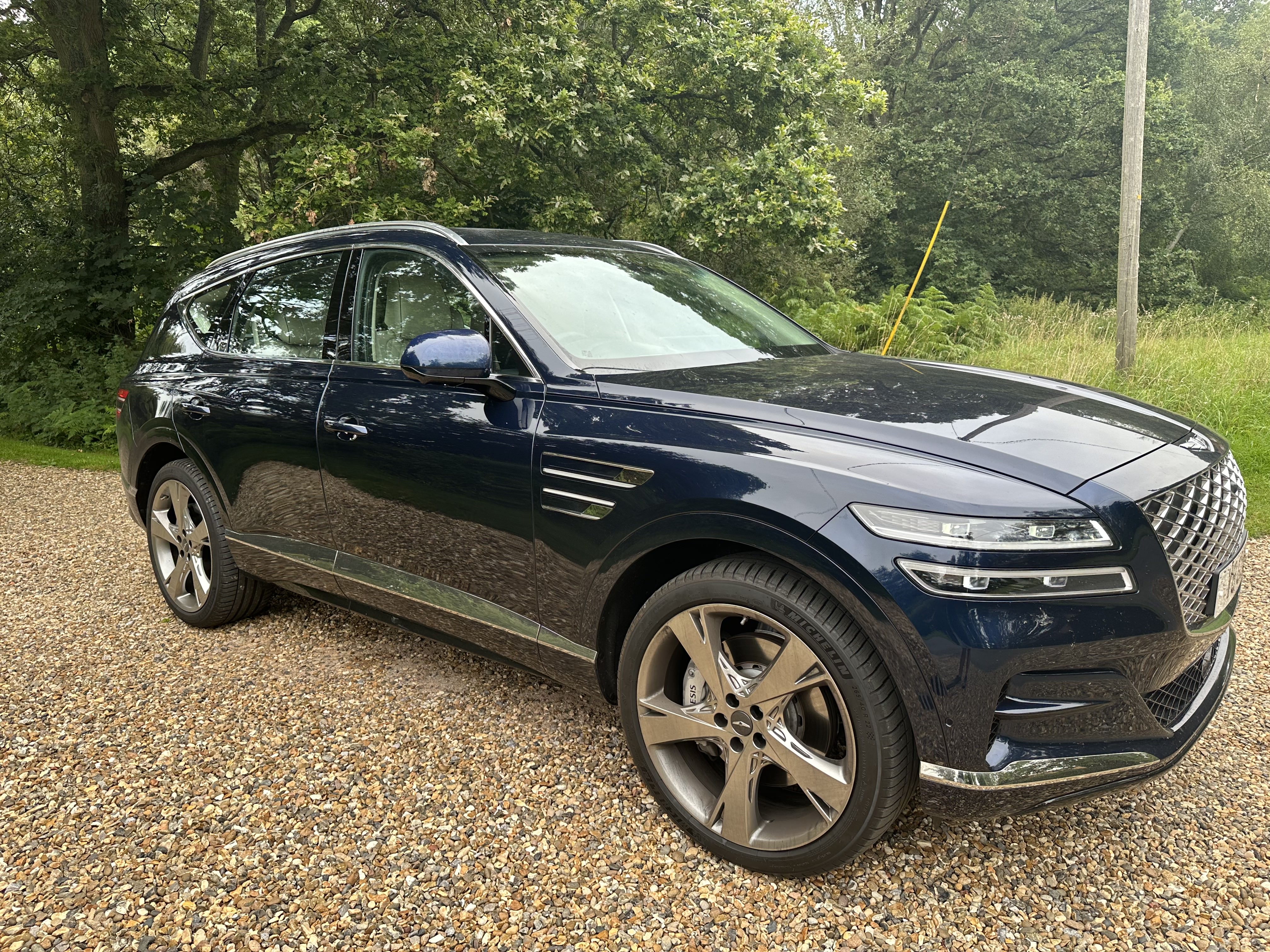
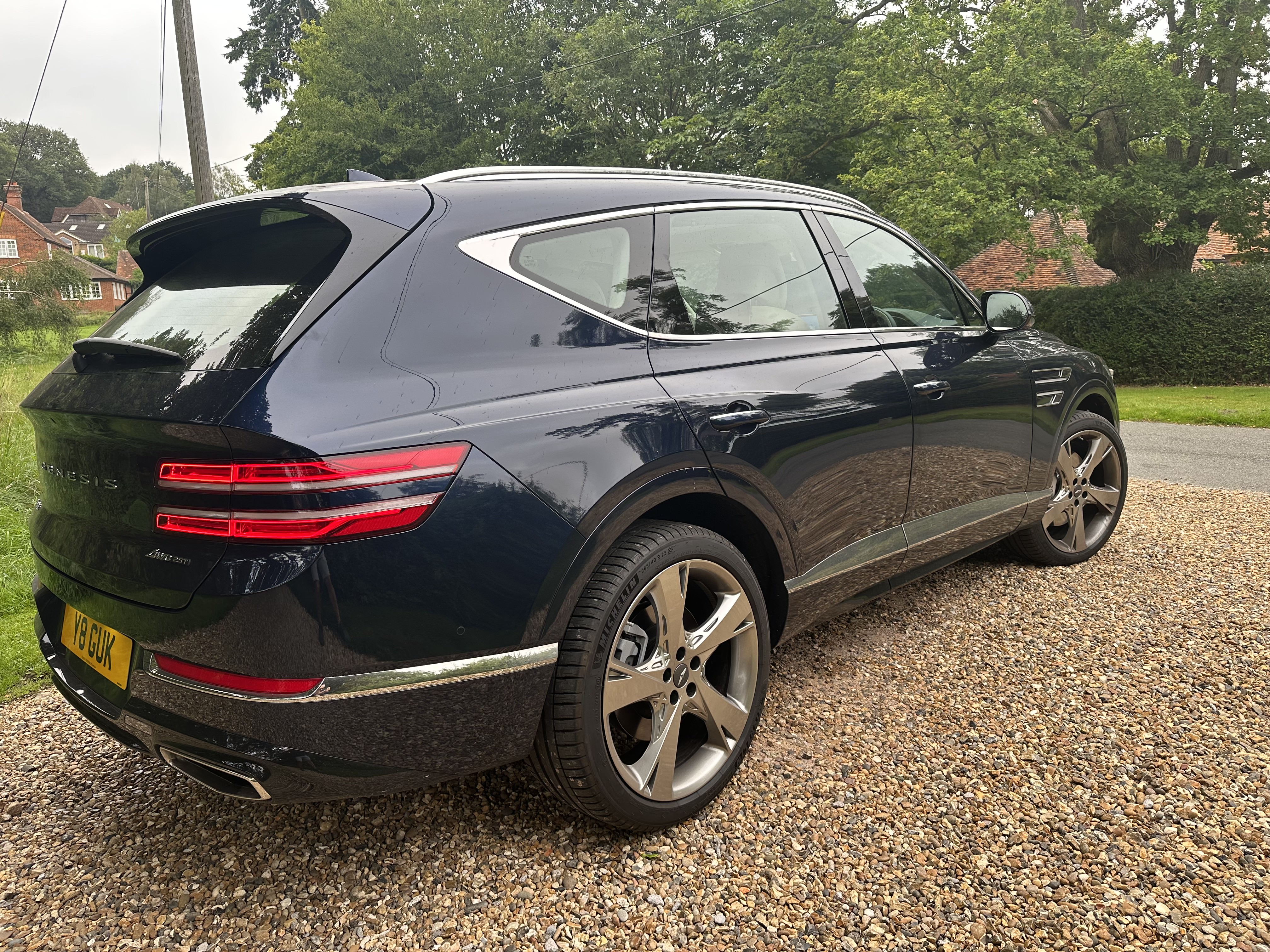
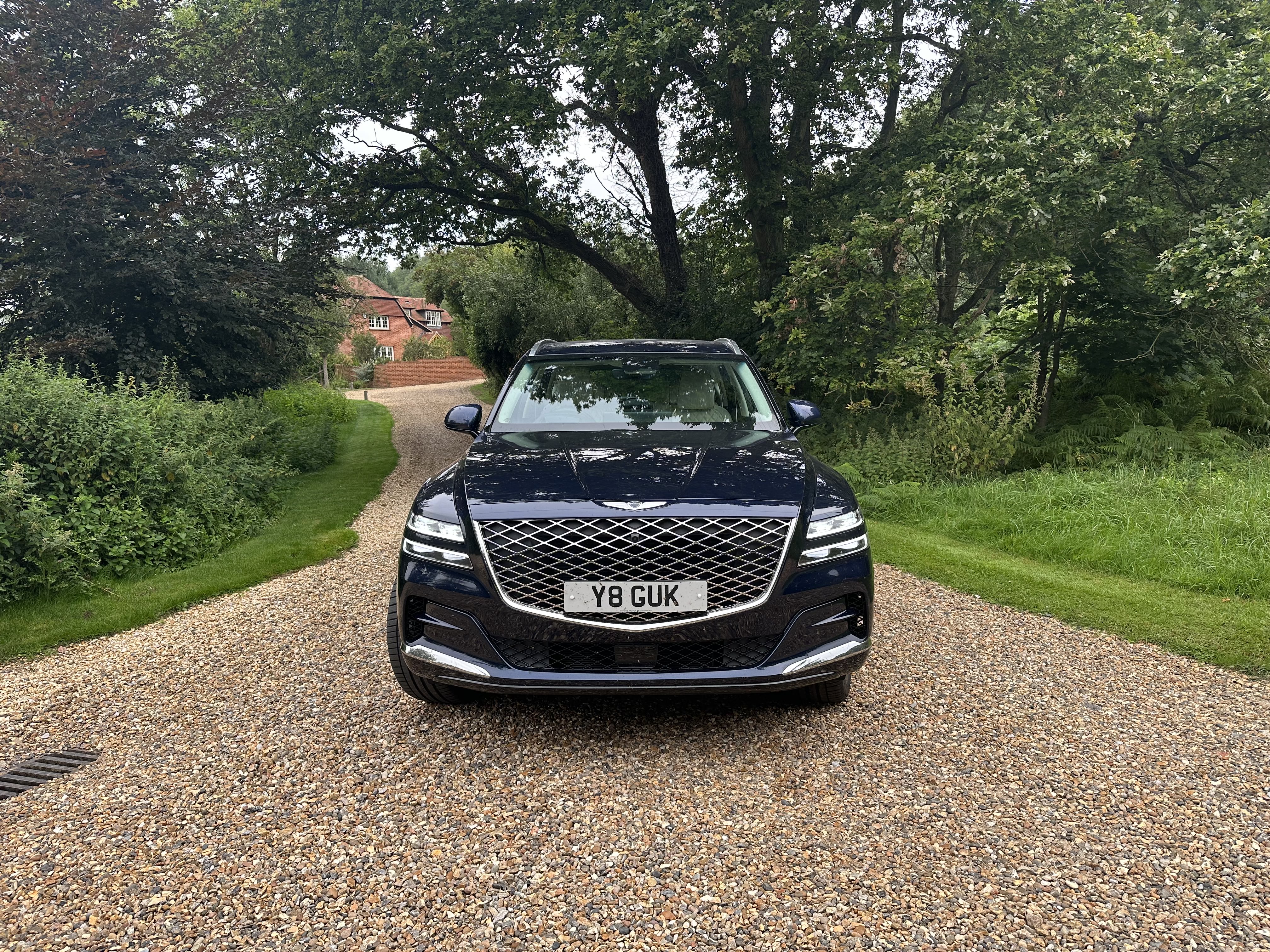

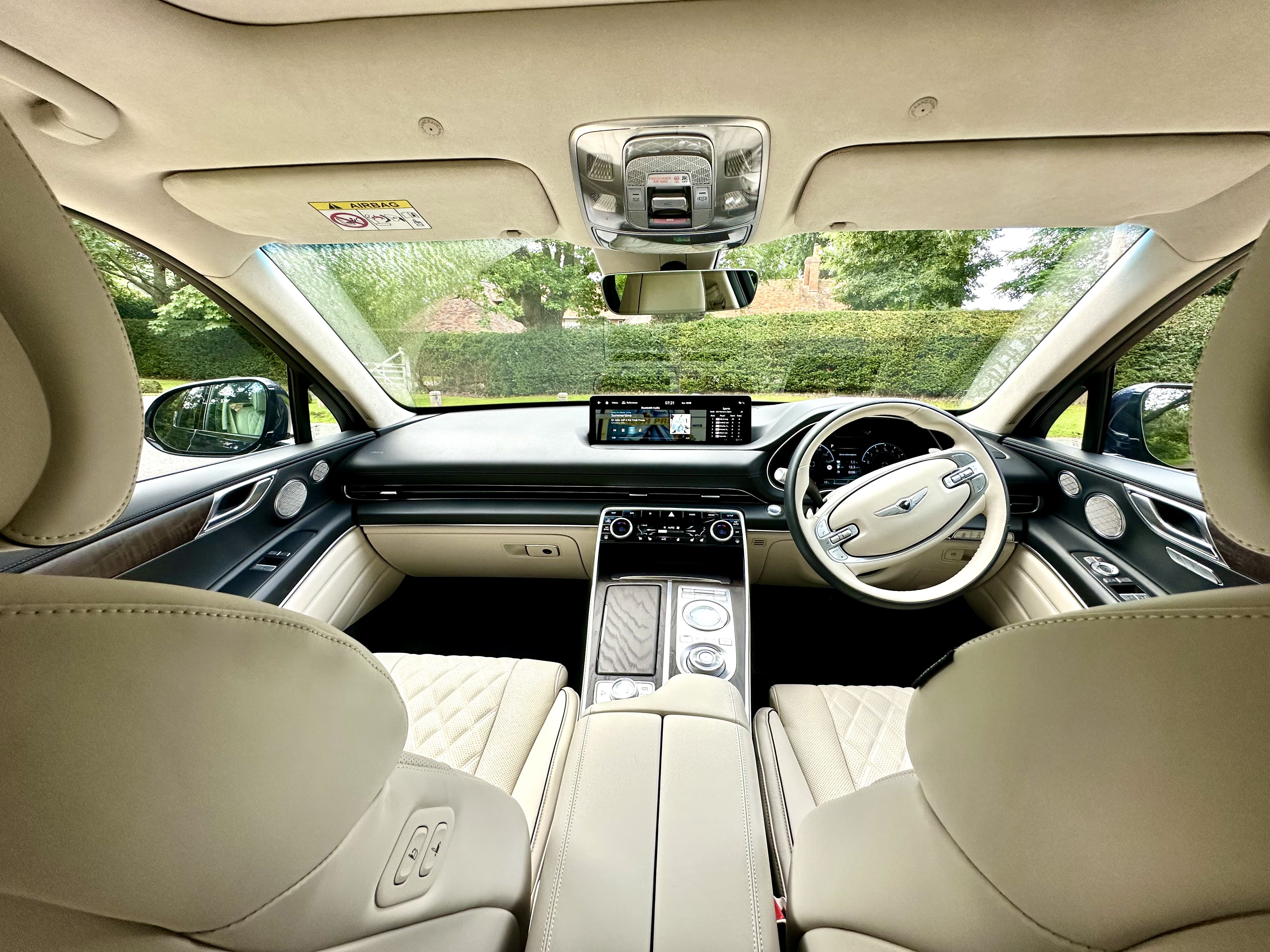
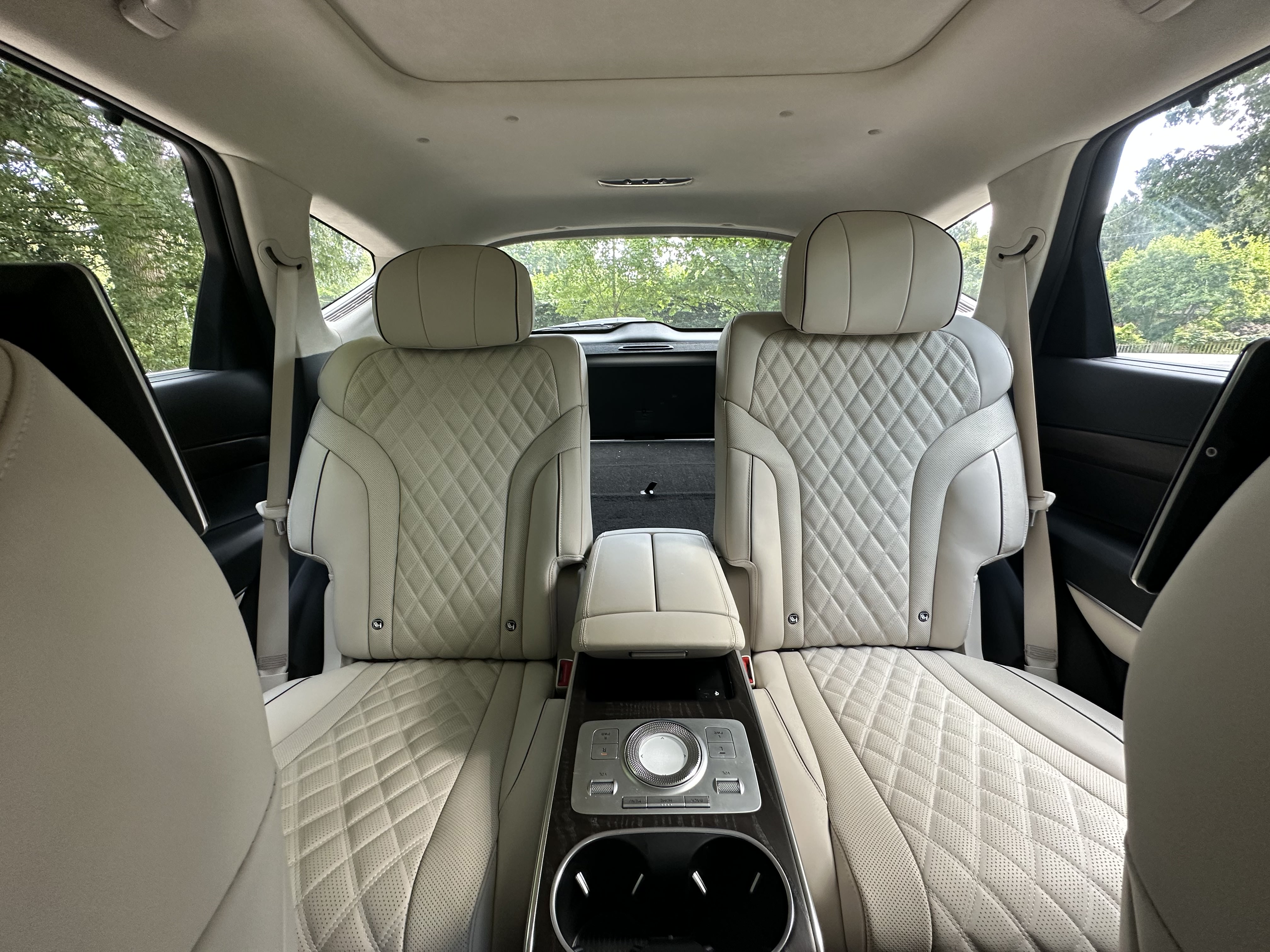

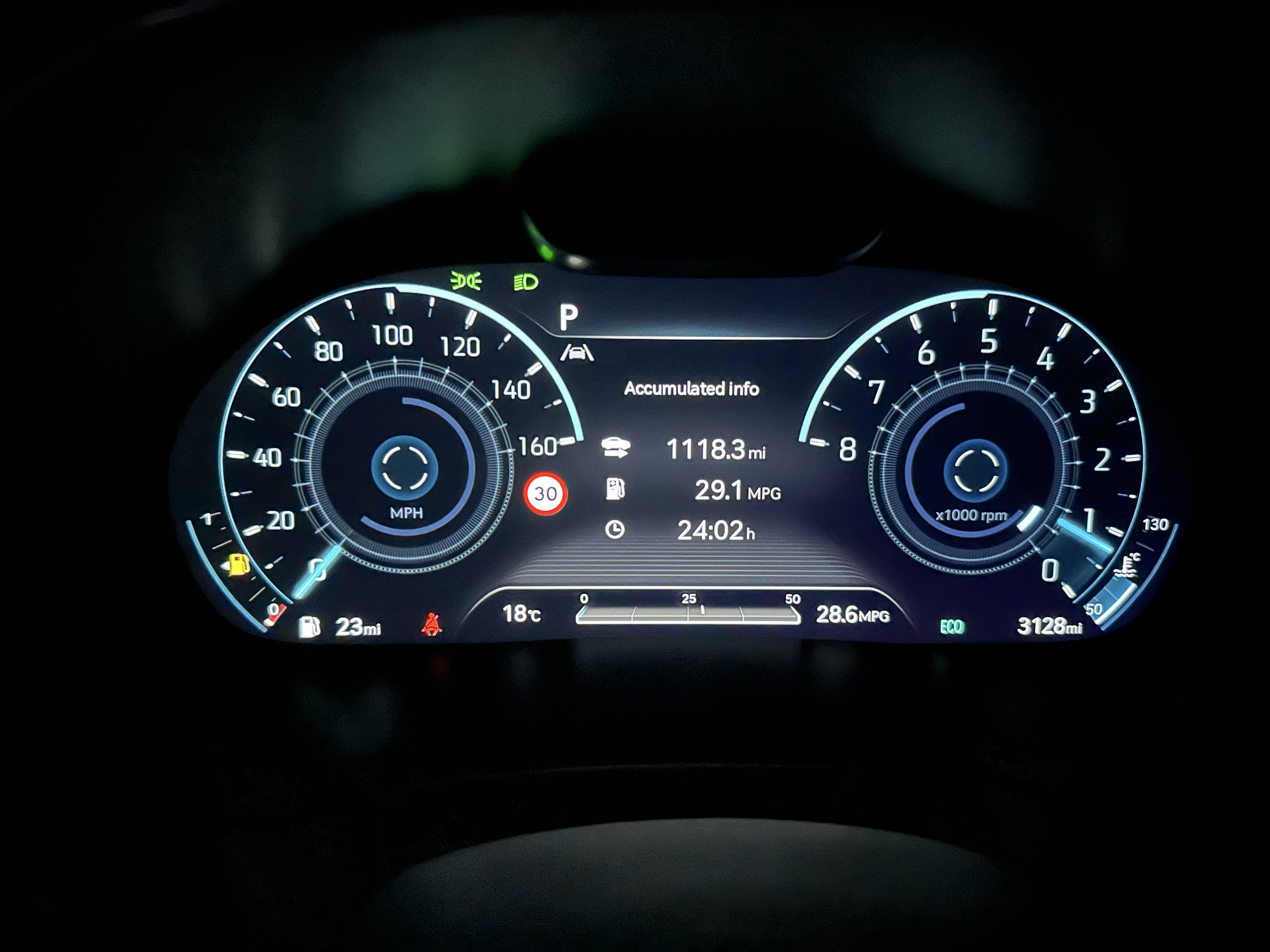
Normally on long road trips, there's a fair bit of pretending to be asleep to avoid an extended stint at the wheel, but not on this occasion. It seems that the type of car that you drive can stop any squabbling of this nature.
The GV80 doesn't quite drive itself but on the long stretches of the M6 and M74 it felt as though it did, with the brilliant adaptive cruise control keeping a set distance to the car in front.
Motorways and dual carriageways are where the Genesis really excels offering supreme comfort for the driver and passengers, but for a big car it also handled well on the drive from the M90 across to St Andrews on some quite wiggly roads.
There’s plenty of power on tap thanks to the 2.5 litre turbo charged engine to ensure smooth overtaking when there was the opportunity, but economy was very respectable too - we managed just shy of 30mpg over the course of the trip.
There's tons of technology in the GV80 to help you drive safely with lane assist and all round cameras ensuring you know exactly where you are on the road and what's around you as you manoeuvre the car in and out of parking spaces and tight spots.
There's so much room in both the front and rear seats with those in the back able to watch their own entertainment on screens in the headrests if they don't want to listen to the main Lexicon Audio Sound system, which is absolutely superb.
Southport & Ainsdale

One of golf's great debates is around which stretch of coastline boasts the finest collection of links golf courses. Is it East Lothian, Fife, The West Coast of Scotland from Troon to Turnberry, or north east Scotland around Aberdeenshire?
All make strong cases. However, for me, nothing quite matches England's Golf Coast that stretches from the Wirral in the south, where you'll find Royal Liverpool and Wallasey, right up to the Lancashire town of Lytham & St Annes in the north. At the heart of this magnificent run, three absolute classics sit side-by-side - from north to south, Royal Birkdale, Hillside and Southport & Ainsdale. It's quite incredible that these three golf courses that share boundary lines with each other can be quite so different in character.
As noted, Southport & Ainsdale has no views of the Irish Sea that you get glimpses of at Hillside and Birkdale. However, it is no less an enjoyable place to play golf because the course has a wonderful inner beauty.
The holes meander between low duneland. At some point in history you would've been able to see water from this piece of land. Such has been the rate at which land has been reclaimed from the sea on this coastline, that moment passed many moons ago.
While you do not see the water, you do play on marvellous tight, sandy playing surfaces. When combined with a very stiff breeze, as we had for the first day of our tour, it exposes your ball striking prowess. Well, it certainly did mine!
S&A, as it's more widely known, has hosted not one but two Ryder Cups (1933 and 1937) and has been the scene of many notable tournaments, most recently jointly hosting The 2023 Amateur Championship with Hillside.
A post shared by Michael Harris (@mickyh_1970)
A photo posted by on
It's a strong start here with a lengthy par 3 played in front of the clubhouse and often a busy terrace, which can make the first shot of the day a knee-knocking experience. If you get a decent one away that misses the bunkers, then the green sits in a a bowl that helps collect shots, so you’ll have a chance of par.
There has been much great work undertaken at S&A in recent years from big projects, like new greens and tees, to the introduction of many grass paths throughout the course, which really add to the journey around this delightful links. Several waste areas have been added which further increases the visual appeal.
The two things I enjoy most about Southport & Ainsdale are the frequent changes in the direction of play which don't allow you to settle into a rhythm, and secondly the excellent variety of length of the par 4s that range from 352 yards up to 457 yards. It makes for a really sporty test which, depending on the wind direction, can make a number of shorter holes driveable and/or make long par 4s play as par fives for all but the biggest hitters.
The finish here is especially strong, both in terms of the test it presents and also in the attractive nature of the holes. Things really get going at the 15th hole, a short but tight par 4 that plays to a small green that sits at an angle to the fairway and has the train line directly behind it. There's something magical to me about playing golf with trains rattling along in close proximity and the bright yellow Merseyrail coaches provide a fast moving splash of colour.
The par 5 16th - Gumbleys - is perhaps Southport & Ainsdale’s most famous hole, where after a drive you play over a huge sleepered cross bunker before an approach to a relatively new green (pushed back from its original site) surrounded by dunes.
The 17th features a beautiful elevated tee (there are a few at S&A that make for an enticing view), but you have to concentrate with out of bounds to the right, which can easily come into play, especially if the wind is off the left.
On the final hole, you drive over some low dunes to a partially hidden fairway. At 352 yards, it's relatively short. Big hitters will be able to get it very close in the right conditions, although there are well-placed fairway bunkers to avoid. The green sits in a slightly raised position with the terrace and clubhouse beyond. It's a fantastic spot to end a round of golf.
The clubhouse itself is a really attractive building from the outside. Inside, it's been stylishly modernised, and there's much history on display with a look around the Ryder Cup Room an absolutely essential part of any visit.
The food is very good (don’t miss the homemade sausage rolls at the halfway hut), the beer excellent and the staff and members incredibly friendly. Southport & Ainsdale proved to be a fantastic start to our trip, setting a very high bar indeed.
Formby

Formby is located just a few miles south of S&A. There are two common factors between the two - the presence of the yellow Merseyrail trains, and the fact you don't get to see the sea (actually you catch glimpse at Formby from the 9th tee, but it's not always been this way).
The old 8th and 9th holes ran closer to the sea but fears over coastal erosion forced the club into taking those holes out of commission and engaging course architect Donald Steele to create new ones in the 1980s, which are now some of the best at Formby.
Although it is a true links (according to Campbell and Peper’s book), Formby is unique in that it actually encompasses three very distinct styles of holes, albeit all played with links conditions underfoot.
Playing the first four holes, you could be mistaken for thinking you were at a classic Heathland course such as Sunningdale, as the fairways run between pine trees and swathes of heather making for an interesting start where there’s a real premium on finding the fairways.
From the 4th green, you cross over a small public footpath before playing two classic links holes. The superb par-3 5th plays to a slightly raised green, and the par-4 6th, over a dune to a blind green following your drive, where it's only possible to see the top of the very tall flagstick.
The 7th hole changes in character again and the three holes that follow are perhaps Formby's most notable stretch playing as they do between pine trees with some stunning changes in elevation.
A post shared by Michael Harris (@mickyh_1970)
A photo posted by on
The par-5 8th is one of my very favourite holes in golf, a sweeping dogleg left that plays up to a two tiered green, from where you get a wonderful view back down the 8th and up the brilliant 9th.
The 10th is a deceptively tricky par 3 that is often hard to club correctly as the tee is sheltered, but as soon as your shot gets up and away it is subject to the vagaries of the seaside winds.
From the 11th hole you are back into what I consider to be pure links land with low dunes framing undulating fairways that cast atmospheric shadows at the start and end of the day.
At the 12th, you have your first encounter with halfway hut. On the day we visited it was staffed by the very jovial Elli. We enjoyed stopping for a drink and a chat, and two holes later we were back, picking up some sustenance before the tough closing stretch
Fourteen and 15 are back-to-back par 4s that play in opposite directions, but regardless of wind are both hard. Sixteen is a tricky par 3 surrounded by three treacherous bunkers and sharp run offs.
The 17th feels like it should be a birdieable par 5 but that will depend on the line you take from the tee. The more aggressive your play towards the right hand side of the fairway and the pine trees, the better for line into a two tier green that falls off sharply to the right.
Onto the 18th. With the tee set back in the trees, it’s an intimidating drive as you face prominent fairway bunkers both left and right at driving distance. If you can negotiate them, you'll have a mid iron to the long final green that sits in front of the splendid clubhouse.
Inside the clubhouse there is lots of history on show. Formby has played host to a number of significant amateur events, perhaps most notably when Jose Maria Olazabal beat Colin Montgomerie in the final of the 1984 Amateur Championship. For real ale enthusiasts there's an excellent selection of very quaffable beers at the bar!
Read our full Formby GC GB&I Top 100 Course Rankings review and visitor information page
Royal Liverpool
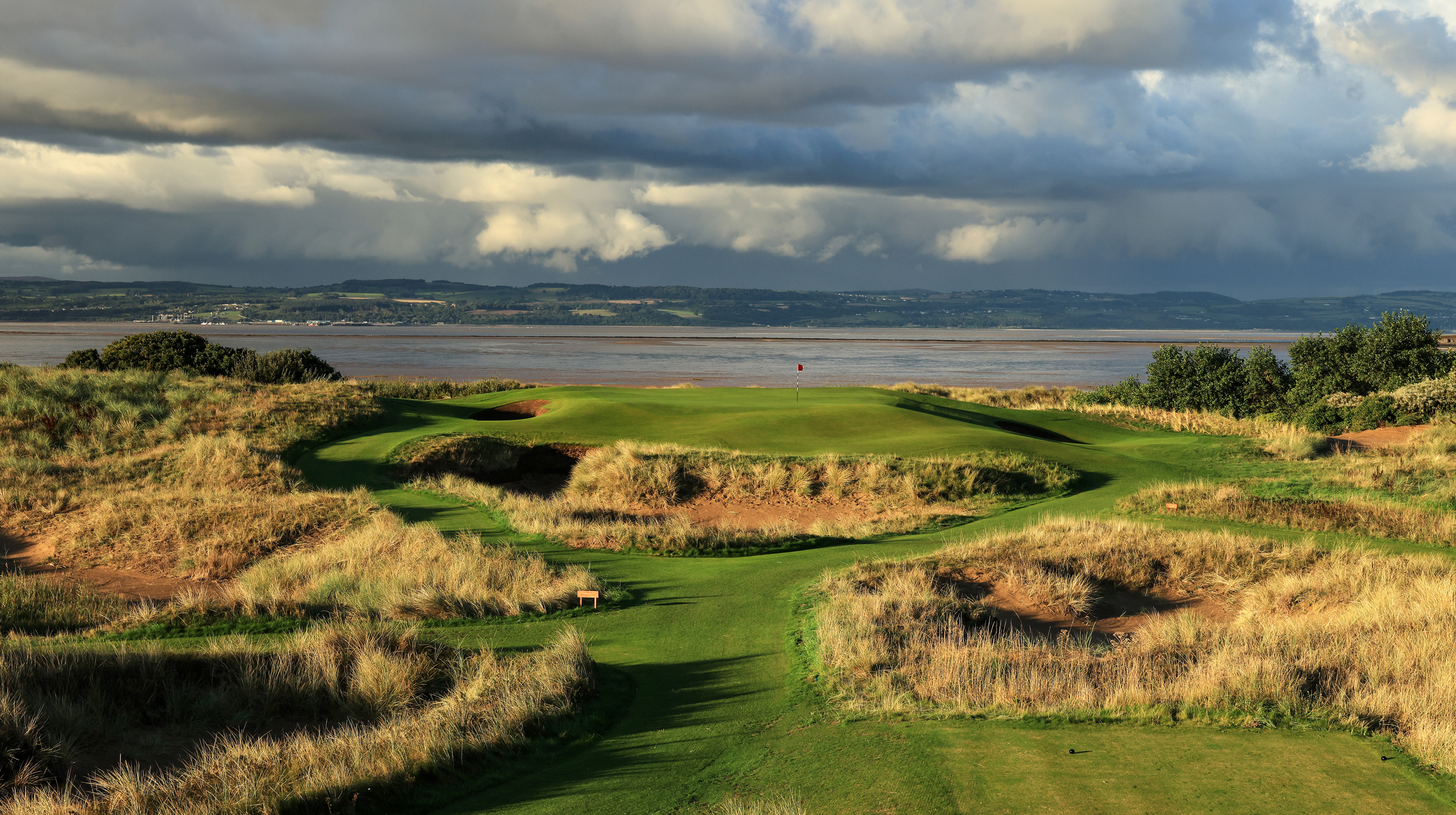
There is a huge sense of occasion as you turn off Meols Drive into the car park at Royal Liverpool Golf Club and are met with the site of the grand, ivy clad, red brick clubhouse. As you get out of your car you know that you are somewhere special.
The anticipation was heightened for our visit, given that we were playing less than a month after the 151st Open Championship had been in town. There was a definite extra buzz around the place and the fact that some grandstands and infrastructure from the Championship were still in place really added to a sense of occasion, as did the fact the course was playing over the Open routing.
Royal Liverpool, or Hoylake as it’s more widely known, is a highly strategic golf course full of subtle challenges. The more you play it, the more you begin to appreciate the nuance of the challenge. But, for first time visitors and seasoned members alike, there’s no doubt what the biggest challenge is here - the bunkers!
All bar a tiny handful are clearly in view from the tee or fairway but knowing where they are, and missing them are two very different things. Fairways often camber towards them taking drives that seemed good into sandy graves and many greens shed all but the perfectly judged approach towards greenside traps.
Go in one of the fairway bunkers and it's pretty much a guaranteed one shot penalty; go in a greenside bunker and your chances of escaping first time are predicated by how close to the face you are and how accomplished you are from the sand.
That said, you shouldn't be scared of playing at Royal Liverpool because there's almost always a safe option away from sand, albeit you will never be able to take it without then facing a tougher next shot.
Unlike Southport & Ainsdale and Formby, you get some magnificent sea views at Royal Liverpool, but you have to wait a while to be rewarded with those, as the first 10 holes of the Championship rooting weave back and forth across the links getting to the stunning elevated 11th tee.
A post shared by Michael Harris (@mickyh_1970)
A photo posted by on
From there you are taken on a rollercoaster run of holes that play alongside the coast, where you have to concentrate hard on the test in front of you and not get too wowed by the views of the glorious Dee Estuary, over to North Wales and out to the Irish Sea.
Over the 150 plus years of Royal Liverpool’s history the routing of the links has changed many times, and for the last three Open Championships the course has had a different routing to the one members usually play. On the downside, it means you get two holes to find your stride before playing the fearsome 1st with its internal OOB.
On the upside, you get possibly the best final three-hole stretch on the Open rota. Sixteen (normally 14 for the members) is a long demanding par 4 to get things going. Only an accurate drive will yield a clear approach to a large two-tiered green that's full of subtle breaks.
From there it’s on to Hoylake’s notorious new short hole, Little Eye, named after one of the three small islands that sit off the coast in the Estuary. Legendary Tour caddie Billy Foster somewhat dramatically called it a monstrosity ahead of the Open and while it certainly has card-wrecking potential, it is only around 120 yards. Aim for the centre of the green and try to get your birdie putt close - Simple(ish)! Personally, I love the hole and think it would be great if it were the 17th for member play.
The final hole, with OOB running down the right hand side, sums up Hoylake’s strategic risk and reward test. The tighter you take it to the small grass cop that marks OOB, the better, the line into the green that you will have for your second and/or third shots. There’s tons of room left but the closer you get to the green so the difficulty of the approach increases from this safe side, as you have to fly a defensive line of bunkers that sit tight to the front of the putting surface. A four (or better) is a great score to finish with.
Back in the splendid clubhouse, take time to soak up some of the incredible history that oozes from every corner and also enjoy a fantastic selection of food and drinks. Our fourball all plumped for the epic breakfast batch (cue lots of debate about regional differences in the naming convention for a bun) and the local beer, Trappers Hat, that's an incredibly refreshing drop after a round of golf.
If the weather is fine, make sure to have a drink on the terrace that overlooks the putting green.
Read our full Royal Liverpool GC GB&I Top 100 Course Rankings review and visitor information page
St Andrews - Old Course

Continuing the theme of just how different one links course can be from another, the Old Course shares only one trait with that of the others we played on this trip, in that you're hitting off glorious tight turf for the duration of your round.
Pretty much everything else is different...the in and out routing, the fact that the 1st and 18th are played against the backdrop of a living, breathing town, that all bar the 1st, 10th and 18th feature double greens and that many of the old courses bunkers are hidden from view - although on the final point, it's interesting to note that when the Old Course is played in reverse,as Golf Monthly colleague, Fergus Bisset got to experience a few years ago, many more of the bunkers are visible.
As a golf experience, playing the Old Course is in a league of its own. For the first timer it's an absolutely giddying experience teeing off in front of The R&A clubhouse (often with a sizeable crowd watching you) and then stepping out onto the famous fairways and following in the footsteps of every significant player to have played the game of golf.
As the round unfolds you’ll play holes (and possibly visit bunkers) that have been made famous by TV broadcasts of Opens, and that helps keep the excitement levels at close to fever pitch. However, they really reach a crescendo as you play famous 17th and 18th.
Detractors, and there are a few, will often say the Old is a three hole course and while 1, 17 and 18 are off the charts in terms of experience, there are some incredible golf holes out on the links.
The holes around ‘The Loop’ (7-11) are, for me, especially brilliant. The 7th hole kicks things off, where after a drive between two mounds, you must play across the vast Shell Bunker to a tricky green. The par-3 8th, where the bottom of the flag is almost always obscured, plays tricks with your mind when it comes to clubbing. The 9th and 10th holes are both sub 350 yard par 4s even from the Black tees, but it's as easy to make a bogey as a birdie. Then there's the 11th, one of the world's greatest par 3s playing back towards the Eden Estuary.
Not only are they a great stretch of holes, but to me they encapsulate what the St Andrews links are all about with groups of golfers often accompanied by caddies performing a century's-old dance, allowing those with the right of way to play first, before either stepping aside, or hurrying up to allow an adjacent group to hit their shots. It's people (and golf) watching at its finest!
The 12th hole starts the run for home, and also an ongoing battle to avoid four hidden bunkers. Even if you miss the sand at the short par 4, you still have to negotiate a very difficult green where the flag almost always sits on a plateau that is incredibly hard to hold, especially down wind.
Thirteen through 16 require bold driving, especially if the prevailing wind is blowing into and off the left pushing you towards trouble, especially at 14 and 16 where OOB is a genuine threat.
A post shared by Michael Harris (@mickyh_1970)
A photo posted by on
As anybody who's ever played the Old will tell you, ‘you can hit it left all day’, and while there is a large element of truth in that, it does also bring into play bunkers, especially at 13 and 14 where the aptly named Coffins and Hell await.
Stood on the 17th tee, first timers and veterans alike are filled with excitement and trepidation in equal measure as they take their turn to play the most famous of golf holes. The yardage book and caddies will tell you to hit it over the old railway sheds that feature the Old Course Hotel crest, but most people will take the safe option to the left of the corner of the sheds and turn this into three shotter.
The best chance of making par at this hole for ordinary golfers is to miss short right and play up the length of this fiendishly narrow green where you’ll almost certainly be attempting to hole out with an audience, who either stop and stare, or are walking quickly to and from the Old Course Hotel (or a pint at the Jigger Inn). It's exciting and off putting in equal measure!
And so to the most famous finishing hole in golf. Aim of the clock on The R&A clubhouse, open your shoulders, and give it a rip. Just as at the 1st, there's normally a crowd (or at least a good few people) around 18 watching golfers hit their approaches and putt out. Good shots garner a warm round of applause, poor ones a deathly hush!
As you shake hands with your playing partners on the 18th you will all know that you've just been fortunate enough to have had one of, if not the greatest, golfing experience the game has to offer. Congratulations, you've most definitely earned a refreshing beverage at one of St Andrews’ many fine pubs!
Read our full St Andrews Old Course GB&I Top 100 Course Rankings review and visitor information page
Dumbarnie Links
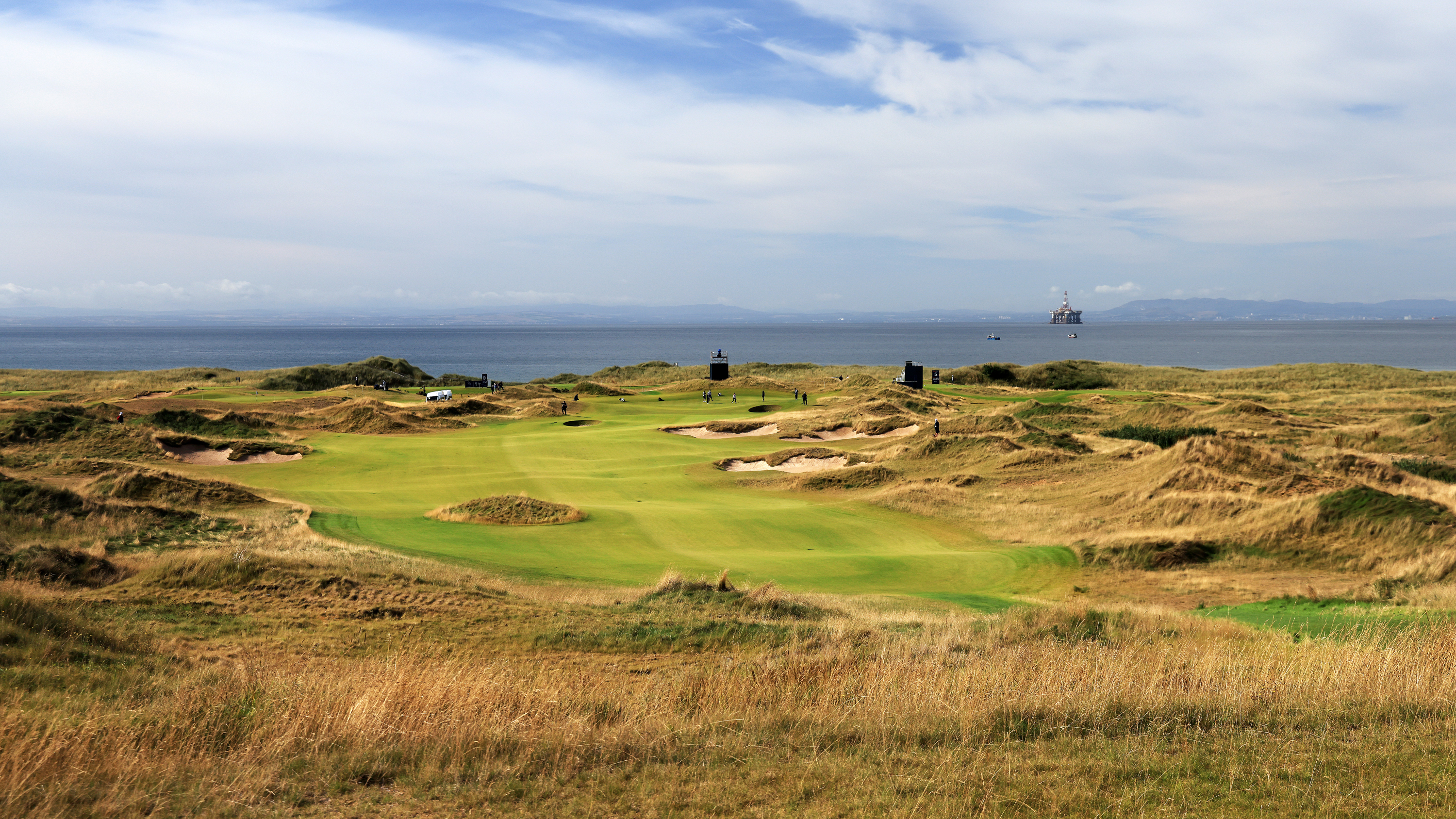
It was very fitting that Malcolm Campbell (he of the Links Golf book and former editor of Golf Monthly) had a very significant hand in the creation of Dumbarnie Links, especially so given that the course was not even a tangible idea at the time the book was published.
Had it, it would most definitely have merited inclusion, as it ticks all the boxes of the criteria. When it opened for play in 2020, there was some chatter as to whether Fife needed yet another links golf course, but in the few short years since it's quickly become a modern classic, finding its way onto the 'must play' lists of every golfer that comes to this corner of Scotland. It's achieved that because of a number of factors.
Firstly, the spectacular views on offer at every single hole, which really are jaw dropping. Secondly, the brilliant routing that course designer Clive Clark has laid out, which offers lots of changes of pace and direction. Thirdly, the number of options off the tee, with plenty of chances for golfers to make birdies if they take on bold plays, and finally the superb clubhouse and welcome on offer to visitors. There are no members here, which, like Kingsbarns further up the road, means there is a super relaxed atmosphere. Visitors want for nothing… including an optional dram on the 1st tee, which we naturally availed of!
A post shared by Michael Harris (@mickyh_1970)
A photo posted by on
Trying to pick out my favourite hole here is tough. For me, the risk reward 17th is an absolute beauty, but I also love the par-5 15th where big hitters can take it up the right hand side to a small peninsula fairway, from where you can have a crack at the green. The rest of us can play at the left hand side, which is longer but less fraught with danger.
What is for sure is there really isn't a weak hole among the 18. The par 3s are particularly brilliant and range in distance from 157 yards to 215 yards off the Black (medal) tees with all four of them playing in a different direction, meaning you're unlikely to hit the same club at more than one of them.
Walking off the superb 18th hole and up to the clubhouse to be greeted by a friendly member of the golf operations team, it's time to have a think about your post round meal in The Old Barn restaurant. The modern menu has lots of options, but for me it has to be the giant and very delicious haddock and chips every time!
Read our full Dumbarnie Links GB&I Top 100 Course Rankings review and visitor information page
And so that was that. Nearly 1,200 miles driven, 90 holes of amazing links golf played, some good shots hit, some bad ones hit, but much laughter and fun had. I’d encourage you to start planning your own road trip.

Mike has been a journalist all his working life, starting out as a football writer with Goal magazine in the 1990s before moving into men’s and women’s lifestyle magazines including Men's Health, In 2003 he joined Golf Monthly and in 2006 he became only the eighth editor in Golf Monthly’s 100-plus year history leading the brand until July 2023. He is now Content Director overseeing Golf Monthly and two other iconic sports brands, FourFourTwo and Rugby World.
His three main passions in golf are courses (he's played over 500 worldwide), equipment (he's always in search of something shiny to give him an edge) and shoes (he owns more pairs than he cares to mention!).
Mike’s handicap index hovers at around 10 and he is a member of six golf clubs: Hartley Wintney, Royal Liverpool, Royal North Devon, Prince's, Royal Norton and the Royal & Ancient Golf Club of St Andrews.
Mike's current What's In The Bag?
Driver: TaylorMade Qi10 10° - Fujikura Ventus Blue 5S - Golf Pride MCC Plus4 grip
Fairway woods: TaylorMade Sim Max 3/15° - Fujikura Ventus Blue 6S & TaylorMade Stealth 7/20° - Fujikura Ventus Red 6S - Golf Pride MCC Plus4 grips
Utility Iron: TaylorMade Stealth UDI 3/21° - Aldila Ascent 90HY - Golf Pride MCC Plus4 grip
Irons: TaylorMade P790 (5-PW) - Fujikura Axiom 75R - Golf Pride MCC Plus4 grips
Wedges: TaylorMade MG4 50°, 54° and 58° - KBS Tour Hi-Rev 2.0 shafts - Golf Pride MCC Plus4 grips
Putter: Evnroll ER2B - Gravity Grip
Ball: TaylorMade - Tour Response (Yellow)
-
 6 Big Pairings Who Missed The Cut At The Zurich Classic Of New Orleans
6 Big Pairings Who Missed The Cut At The Zurich Classic Of New OrleansA range of pairings are in contention at the Zurich Classic Of New Orleans, where a number of big groups also failed to make it into the weekend
By Matt Cradock
-
 PGA Tour Truist Championship Creator Classic Line-Up And Format Revealed
PGA Tour Truist Championship Creator Classic Line-Up And Format RevealedThe PGA Tour has announced the line-up for the second Creator Classic ahead of the Truist Championship - with YouTubers from outside golf taking on the challenge
By Paul Higham